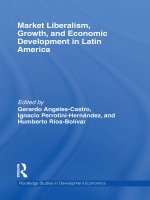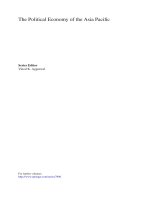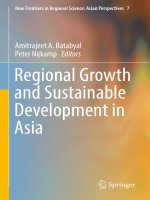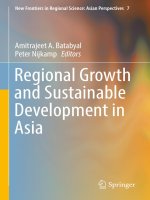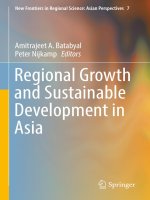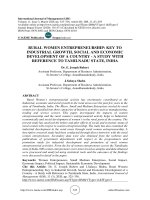Economic growth and economic development 666
Bạn đang xem bản rút gọn của tài liệu. Xem và tải ngay bản đầy đủ của tài liệu tại đây (101.83 KB, 1 trang )
Introduction to Modern Economic Growth
fraction ϕ of workers employed in the final good production will not be able to adapt
to this new technology and will need to remain unemployed for one time period to
“retool”.
(1) Define an equilibrium in this economy. [Hint: also specify the number of
unemployed workers in equilibrium].
(2) Characterize the balanced growth path of this economy and determine the
number of unemployed workers in equilibrium.
(3) Show that the economy will experience bursts of unemployment, followed
by periods of full employment.
(4) Show that a decline in ρ will increase the average growth rate and the
average unemployment rate in the economy.
Exercise 14.18. * Derive equations (14.28)-(14.30).
Exercise 14.19. * Consider the model discussed in subsection 14.2.2.
(1) Choose a functional form for η (·) such that equations (14.30) have solutions
L1R and L2R 6= L1R . Explain why, when such solutions exist, there is a perfect
foresight equilibrium with two-period endogenous cycles.
(2) Show that even when solutions exist, there also exists a steady-state equilibrium with constant research.
(3) Show that when such solutions do not exist, there exists an equilibrium
which exhibits oscillatory transitional dynamics converging to the steady
state characterized in 2 above.
Exercise 14.20. * Show that the results of the model in subsection 14.2.2 generalize
when there is a single firm undertaking research, thus internalizing the effect of LR
on η (LR ).
Exercise 14.21. * Derive equation (14.37).
Exercise
14.22. * Derive equation
(14.50). [Hint: write ln Y (t) =
i
R1h
Y (t) −n(ν)
ln qi (ν, t) + ln w(t) λ
dν and rearrange this equation]
0
R1
0
ln q (ν, t) l (ν, t) dν =
Exercise 14.23. * Prove Proposition 14.7.
Exercise 14.24. * Complete the proof of Proposition 14.8, in particular, prove that
z0∗ > z1∗ [Hint: use similar arguments to the first part of the proof.]
652
